Part 5: Potala Palace, Serra Monastery and Mandala Temple
Sunday
We finally felt half human after a good nights sleep. After a late breakfast it was off to the capital of Tibetan Buddhism, the Potala Palace.
Luckily we drove almost to the top and entered the Palace from the rear. It was dark, dank and mysterious. It was both beautiful and overwhelming. Every inch seemed covered in fabrics, paintings, carvings or storage for the seemingly endless relics, statues, stupas, thrones or books.
An occasional ray of sunlight would brighten a small nook, vignette or hallway. Otherwise much of the place felt ominous and forbidding. You could almost hear the chanting of mantras and the praying of monks. But that was in the imagination because the sense of silence was almost overwhelming.
There was a pervasive smell of yak butter candles burning relentlessly. The odor was inescapable. The smell of putrid yak butter candles was everywhere. Most of the poor, faithful residents of Lhasa are subsistence farmers. The only offering they have is leftover yak butter just before it turns and can no longer be used for food or drink.
The candles were everywhere in the palace. New yak butter would be mounded over old, the old would turn rotten and rancid with age and the burning. There were many empty rooms we entered only to startle the rats and mice, sending them scurrying away from their meal of the vile liquid goo.
There was also a profound sense of sadness. This had been the traditional seat of government and the center of Buddhist religion. It now sat powerless, almost lifeless, like an old attic mothballed and waiting for discovery and rejuvenation.
We made our way through countless rooms and a series of courtyards to a vast set of stairs leading down and out of the complex. It was a magnificent visit, well beyond our wildest expectations.
Thank goodness the cultural revolution had not destroyed this place as it had so many many other treasures of the Tibetan society.
After lunch and a brief rest, we embarked to the Sera Monastery on the edge of Lhasa. A whitewashed village with narrow streets and passageways with raised platforms on which the buildings stood. The monastery was home to 900 monks, all draped in heavy maroon and brick colored robes. We spotted a small group smashing yak bones for that evenings soup. It was a fascinating peek at local Buddhist monks daily life. It was a powerful juxtaposition to anything Western.
Our last stop of the day was the Mandala Temple. The second most important temple in Tibet. Pilgrims from all over Tibet and the world make great sacrifices to make a pilgrimage to this temple.
Ironically, this afternoon there are only tourists inside the temple grounds. The exit from the temple led directly to a large bazaar that surrounded the temple. This is where the pilgrims came to conduct their rituals. And where ever there are customers, there are local marketplaces.
This market followed the parade of pilgrims around the temple in a counter clockwise direction. They were dressed in their local dress that varied from region to region. The ladies wore their wealth of turquoise and coral woven into their hair or latched to their belts.
Men wore various forms of head gear. Some looked daunting, others quite fierce with bones in their hair and daggers on their belts.
Surprisingly, what was most peculiar was that WE were the oddity and the pilgrims the norm. It seems few tourists wandered into the marketplace. We were the oddity, a novelty to be ogled and studied, often with amusement to the pilgrims.
Surprisingly, of special interest, was an act of negotiating a transaction. A purchase would attract quite a crowd while the process of haggling for the ‘right price’ took place.
Even more attention was give to the payment itself. A crush of eyes were upon us. Where did we keep our money? How much did we have? Where were our secret pouches, where were our hidden valuables… Unnerving to say the least but consistent with their way of life.
John was a pro at bargaining. So when we found a solid turquoise bowl, he was fully engaged to get the best price. After much a do, John and the merchant were deadlocked. I asked John what was the price gap, he told me and I quickly calculated the difference. I leaned into John’s ear and whispered, you are arguing over a quarter. Give her her price and let’s go.
Dinner that evening was a bizarre experience. It was a new modern restaurant with granite and marble everywhere. The weather was considered warm by local standards. By our standards, it was freezing. So there we were with jackets and ski caps waiting for our yak burgers and french fries…
Next: Part 6, The final post in this series. The Yangtze River and the Three Gorges (before the dam).
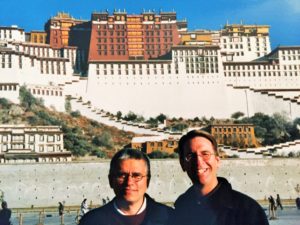

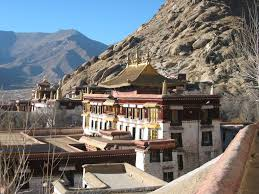
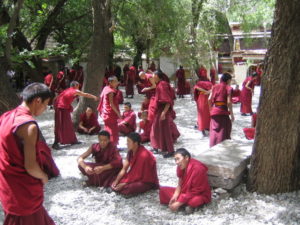
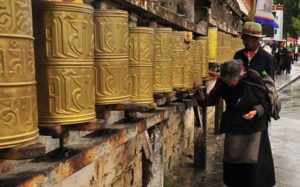
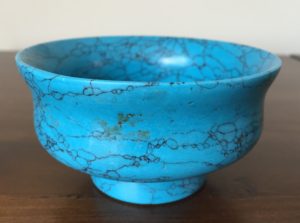
Fascinating adventure and excellent story telling. I feel like I’m there! Keep them coming!
I especially like the picture of the two thin, handsome young men in front of the palace.